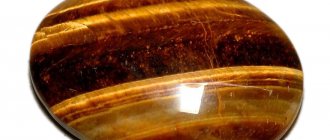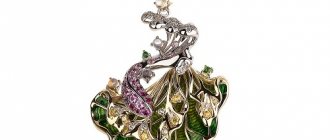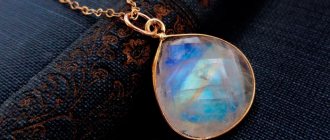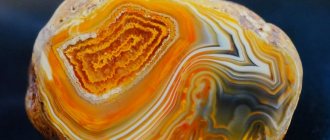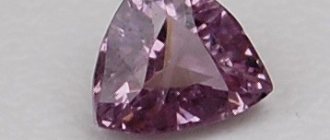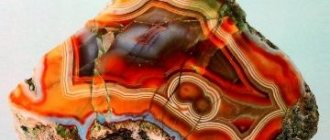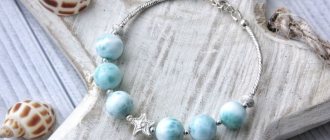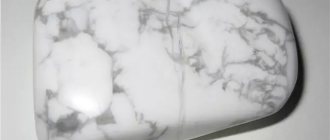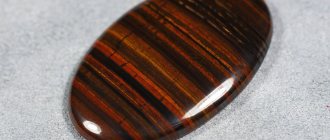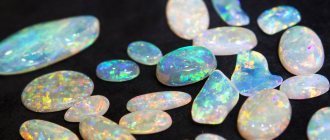“Find me a moonstone...” was sung in one famous Soviet song, and it’s not without reason that moonstone or opalite stone has been considered a talisman of sensuality and love since ancient times.
Let's consider the main properties, names, qualities and legends about this gem. Opalite is one of the most mysterious gems. Its properties are surrounded by many legends and rumors, and its beauty makes it one of the most popular minerals in jewelry.
How opalite was discovered
Opalite is an artificial glass stone.
Natural opals and moonstones of jewelry quality without defects and chips are quite rare in nature, so the cost of such minerals is high. This gave impetus to studying the possibilities of producing artificial analogues. The first attempts were made in Ancient Rome. In those days, the technology for making glass products was imperfect. The first high-quality imitation of opal in laboratory conditions was obtained in 1972 by Pierre Gilson.
Now opalites are produced in:
- Switzerland;
- USA;
- Japan;
- China;
- India;
- France.
The technology for making such gems is constantly being improved. Nowadays, in the production of stones, special opal glass with the addition of calcium phosphate, aluminum and sodium fluoride, calcium fluoride, etc. is used. The material is painted evenly. In addition, the resulting specimens are carefully polished with sugar paste.
How to spot a fake?
You can often find fake moonstones on sale. This is due to the gradual depletion of valuable mineral reserves in the deposits of Sri Lanka, the USA, Mexico and other countries of the world. Glass or plastic is used to produce artificial opalite. Every year, technologies for manufacturing unnatural semi-precious stones become more and more advanced. The majority of such products come from India.
You can distinguish a natural moonstone from a fake in the following ways:
- Real opalite looks less bright compared to artificial opalite; shining highlights in the mineral appear when viewed from a certain angle.
- By turning the stone along its axis, you can observe a change in the play of light refracted in its layers. The radiance of artificial opalite does not change when the position of the gem changes. Its highlights are sharper and more geometrically defined.
- Moonstone is associated with the element of Water, so it is enough to hold the mineral in it for several hours to enhance the brightness of its tints. A fake product does not change its properties after immersion in water.
- The surface of opalite is silky in appearance, the stone is cold to the touch and takes a long time to heat up in your hands.
- When viewed in the light, even stripes are sometimes visible on the sides of the artificial moonstone at the junction of layers of material. And also, against the background of the upper, lighter and more transparent layers, a darker colored substrate can stand out.
- In synthetic opalite that has undergone high-temperature treatment, under a microscope, and in some cases with the naked eye, small cracks filled with air bubbles are detected.
- The buyer should be wary of the low cost of the mineral - the price of natural moonstone is not inferior to prices for gold products.
- The color of natural adularia is not deep pink, blue or green.
The most accurate way to verify the authenticity of a mineral is gemological examination in laboratory conditions.
Appearance of moonstone
Now manufacturers produce opalites of all colors. The line includes both samples that imitate natural stones and samples of unusual shades. Their peculiarity is the optical light effect that occurs due to the refraction of rays when they are reflected from particles of additives present inside the glass.
Color variations
In the classification used in jewelry, there are the following color groups of opalites:
- Black - all specimens of dark shades, incl. dark green, blue, black, etc.
- Pink - pink and yellow-orange opalites.
- "Harlequin" - specimens of white and blue shades with iridescence and a characteristic glow.
- "Dragon's Breath" - transparent bright red samples.
- “Sea” - opalites of blue-green shades.
- "Oxblood" - opaque red specimens.
Opalite comes in different shapes, colors and sizes.
How to distinguish natural stone
It is incorrect to consider opalite as a fake of opal and moonstone. The gem obtained in laboratory conditions is an independent semi-precious crystal. However, passing off opalite as natural opal is a scam. There are a number of parameters that allow you to distinguish between these gems.
The naturally occurring mineral has a layered structure, which results in light being reflected at different angles. This creates the effect of sunbeams inside the sample. Reflections can be of different colors. Opalites have a uniform glow. A similar effect occurs due to the homogeneity of the structure.
To verify the authenticity of a stone, X-rays are often used. Under this influence, a white-violet light emanates from the opal. Opalite does not have such an effect.
To determine whether a stone is natural, you can use a magnifying glass. When magnified, the layered structure is clearly visible.
To determine natural opal, a water test is often used. In this environment, the natural gem will become brighter, and the artificial one will fade. Opalite is characterized by greater thermal conductivity. Glass heats up faster than natural gemstones. Natural opal must have a certificate of conformity. This document indicates the name of the mineral, as well as its country of origin.
You can check the authenticity of a gem using water.
What does it look like and where does it live?
Opalite is one of the most mysterious gems, the color range of which ranges from white to black. The stone has thin plates, thanks to which radiant shimmers of bluish or light blue color are created. Exceptional specimens may have a golden or reddish hue. Opalite is fragile and soft, so even minor impacts can damage its surface. The stone is considered semi-precious and is often used in jewelry making.
One of the deposits of the mineral is the Adula Mountains, but opalite can also be found in Austria. The most popular is blue opalite, which is characterized by transparency or a milky sheen. The black stone shimmers in red, orange and bright yellow. The best breeds are found in Myanmar and on the island of Sri Lanka. Gem deposits have also been discovered in the regions of the Russian Federation.
Origin
Many people know opalite under another name, namely adularia, which it received thanks to one of its deposits - the Adul Mountains, located in Switzerland. Opalite is distinguished by its richness and density of shades, which shimmer under the light of the moon, which gives it another name: “moonstone”. The inhabitants of ancient Asia considered this gem sacred and worshiped it.
Who is the stone suitable for?
Products with stones must be selected taking into account individual compatibility. To determine it, you should take into account your date of birth, name and zodiac sign.
By name
If the opalite is compatible with the owner's name, it will bring good luck and have a positive effect on the person's health. The stone compensates for missing character traits and minimizes negative personality traits.
Opalite is well suited for owners of the following names:
- Irina;
- Anastasia;
- Olesya;
- Elena;
- Ruslan;
- Novel.
Names of people with whom Opalite is compatible.
Horoscope
Opalite is compatible with all zodiac signs belonging to the element of Water. It suits Scorpios, Cancers, Aquarius and Pisces well. For people born under these signs, the stone will become an emotional balancer. The gem will relieve anxiety and worries. Virgos will also benefit greatly from contact with opalite. The stone will help you find love and create a strong family. Wearing jewelry with opalite is recommended for Libra. The gem will help people of this zodiac sign to reveal their talents.
Which zodiac signs does opal suit?
This amazing stone is considered the patron of two zodiac signs:
- Capricorns are recommended to wear a beautiful gem in order to soften certain character traits: uncertainty, tediousness, selfishness, increased anxiety. The magic mineral can relieve the owner from frequent stress and depression. By nature, Capricorn is a zodiac sign characterized by calmness and equanimity. According to these characteristics, it is very similar to opal. However, the peaceful calm of the mineral is strikingly different from the fears of a person hiding behind a mask of equanimity. A suitable opal will help Capricorns compensate for their lack of self-confidence and teach them to open up to loved ones.
- Libras, like opals, are friendly. They do not recognize negativity in relationships between people. But at the same time, the stone, like the representatives of these zodiac signs, symbolizes impermanence. People often suffer from a lack of harmony, the deficiency of which can be compensated by the gem. Libras are characterized by frequent mood swings and an unbalanced character. And opal helps soften these sharp edges and achieve balance. The gem perfectly protects representatives of the sign from going to extremes. It helps to apply mood swings in the creative field.
Of course, the significance of opal stones in astrology is enormous. Any sign can wear these beautiful minerals. In each case, gems will help and protect.
Silver ring with opals (go to the SUNLIGHT catalogue)
What does scorch stone cure?
It is believed that contact with opalite helps eliminate stress and chronic inflammatory processes. In addition, this gem, in combination with other traditional medicine, helps a person get rid of nervous tension and reduces the risk of emotional breakdowns. In people suffering from epilepsy, contact with opalite reduces the number of seizures. The gem relieves nightmares and improves sleep quality.
Opalite improves night sleep.
Opalite has a beneficial effect on the condition of the digestive and urinary systems. Contact with this stone prevents the formation of kidney stones. The gem helps eliminate inflammatory diseases of the respiratory tract. In addition, it reduces the severity of asthma symptoms. Opalite has a beneficial effect on hematopoietic processes and improves hormonal levels.
Jewelry with a gem is recommended for pregnant women. This will have a beneficial effect on the course of pregnancy and will facilitate the birth process.
Compatibility with other stones
Opals are precious stones based on water. Therefore, opal combines well with earth elements. In such a tandem, they better demonstrate their unique qualities.
- Aquamarine
- Coral
- Nephritis
- Gazenite
- Emerald
- Malachite
- Turquoise
- Aventurine
You cannot combine opal crystals with air crystals because when paired they will conflict and cause vibrations that are unpleasant for a person. Opals are incompatible with minerals whose patron is fire: rubies, garnets, pyropes, amethysts.
Magical properties of the stone
Esotericists believe that the Moon gives opalite its magical power. The gem is able to enhance the spiritual component of the owner and attract material wealth. The energy of the stone increases during the full moon and decreases during the darkening of the moon.
The spiritual component of the owner
Artificial moonstone is a powerful amulet that protects against damage and other negative magical effects. Opalite enhances a person's creative abilities and helps to find inspiration. The stone has a beneficial effect on character traits, reducing aggressiveness and temper.
Contact with a gem helps to find peace of mind and moderate arrogance. In addition, under the influence of this stone a person becomes more kind and tolerant of others. Opalite is used in spiritual practices and meditation.
The stone is recommended to be used during meditation.
Material wealth
The gem helps a person concentrate on performing work duties. This contributes to rapid advancement on the career ladder. Opalite attracts good luck. For people involved in business, the gem will help them make useful contacts.
Opalite attracts material well-being. Under the influence of the gem, a person will successfully invest money. When contacting a stone, there is a high probability of receiving unexpected material benefits from distant relatives.
Relationships and love
For single people, the gem will help them meet their other half. The influence of opalite helps improve family relationships. Spouses, even after a long period of resentment and quarrels, will come to mutual understanding.
The flickering of opalite contributes to the emergence of common goals and interests between men and women. This will revive old feelings and bring passion back into the relationship. It is believed that artificial moonstone protects against betrayal and betrayal in the family.
Varieties of precious opals
There are hundreds of varieties of precious opals, ranging from slightly cloudy to clear with rich hues.
- Peruvian (blue). They have increased transparency and have shades from blue to dark blue. Sometimes with a tint of green.
- Lechos opal is visually indistinguishable from emerald.
- Cat's eye opal consists of yellow hues with a stripe down the center and iridescence.
- Black opal is the most expensive in its class, but it does not always have black iridescence; the class of black opals includes gray, dark blue, and purple stones.
- Fire opal is bright red or orange in color.
- Brazilian opal has the lowest percentage of water making it the hardest
- Australian opal has a bright orange color with a red tint.
Rainbow specimens of opal are mined only in Mesquique; at the same time, the deposits of Latin America are rich in transparent opal and Harlequin opal - the stone amazes with its tints of color, the fluorescence of the stone is reminiscent of the play of stones in a children's kaleidoscope.
Stones of the 2nd and 3rd rows (semi-precious, ornamental) are ordinary opals. They do not have rich colors and are less transparent. Among them there are also beautiful and famous ones. They have their own names, often do not look like classic opals at all, but somehow belong to the opal or semi-opal variety.
- Cacholong is similar to porcelain. Has a white color.
- Hydrophane with pronounced porosity, cloudy. An interesting feature of the stone is that the mineral becomes completely transparent in water.
- Prosopal has the color of a green apple and is not transparent.
- Opal-onyx is yellow in color with red and rust stripes.
- Opal-agate.
- Jasper opal has bright red and reddish-brown hues due to iron oxide.
- Dendritic opals are milky or creamy beige in color. It is very interesting because the inclusions form a pattern: moss, leaves, twigs.
- Boulder is mined in the Australian state of Queensland. Its uniqueness is that it has red veins of iron ore.
- Koroite consists of iron ore with veins of opal.
Green and pink opal are often confused with selenite. The difference is that moonstone has a crystalline structure with a shine inside, similar to the northern lights. Opal always has an unusual pattern, looking like a fireworks display of colors.
How to choose talismans and amulets with opalite
It is better to buy rings and earrings with opalite as a talisman. Being on the owner’s hand, the gem will attract good luck to business and make all of a person’s undertakings profitable. Wearing earrings with this stone eliminates unnecessary thoughts, helping you concentrate on your goals. Such a talisman will eliminate unnecessary doubts and help you find happiness in your personal life. It is better to use pendants made of silver with opalite as an amulet. The product will protect a person from any negative magical effects. The amulet will help get rid of hidden ill-wishers.
Jewelry with opalite gives the owner luck and prosperity.
Artificial opals
Scientists in Australia were the first to make synthetic stones, then jewelry houses in Switzerland took over the baton and were able to grow unique opals in a color uncharacteristic of nature in the laboratory: bright pink, deep blue and white.
In Russia, Japan and China, they learned to grow unique minerals with high hardness within a year and a half; this characteristic of artificial stone is highly valued by jewelers. Because in this case the stone can be cut in various ways.
Artificial stones are useless for magical and healing actions, have no properties. Apart from decorative properties, such minerals have no value.
Care and wear of opalite
Opalite is a fairly fragile material, so products with it must be worn carefully. A fall or other accidental mechanical impact can lead to chips and cracks. In addition, this gem is not resistant to household chemicals and temperature changes. It is necessary to avoid prolonged exposure of the stone to direct sunlight.
Opalite requires careful care. Approximately once every 2 weeks, wash the product in warm soapy water and rub with a soft velor cloth. It is better to store such jewelry in a fabric case.
Opal - physical properties
Opal is silica in amorphous form, chemically similar to quartz. The difference between opals and standard quartz is the large percentage of water in the mineral, on average 15% of the weight of the stone itself.
- The chemical formula of the mineral is SIO2-nH2O.
- The composition is silicon dioxide hydrate.
- The average hardness of gemmopal ranges from 5.5 to 6.5 on the Mohs scale.
- Density 1.96-2.20 g/cm3.
The mineral should not be exposed to strong temperature changes (cooling and heating). The stone will lose color and structure.
Healing properties of opals
Opal has, according to lithotherapists, many healing properties.
- People become more resilient to stress.
- Normalizes the nervous system.
- Improves mental performance and improves mood
- Relieves nervous tics, reduces muscle tension
- Helps improve heart muscle function by helping to normalize heart rhythm.
- Improves vision and general condition of the eyeballs.
- Normalizes gastric motility and helps digest food.
- Facilitates childbirth and reduces body hair growth for women.
- Cleanses the body by dissolving toxins.
- Relieves toothache and headaches
In the east it is believed that this stone is the most healing. Sick people wore a ring on the index finger of their right hand.
There is a belief that opals become dull pale before their owner becomes seriously ill, of course this information is not verified.
Nowadays, lithotherapists classify opals for their healing properties depending on the type and color of the stone:
- Pink will help with cardiovascular diseases and normalize blood pressure.
- Blues and shades of this color help with mental health. Heavenly stones help normalize emotional state
- Green jewels are responsible for vision and hearing. Use this stone for a cosmetic massage between the eyebrows at least once a day.
- All precious opals, according to researchers, improve the functioning of the gastrointestinal tract and improve metabolism. As a result, the stone can help create a slimmer figure.
Caring for opal jewelry
Opal is a very delicate stone and requires some care. Simple recommendations will help you.
- A regular brush and soap solution will help you wash the stone.
- After washing, leave the product for several hours, wrapping it in a damp towel.
- The stone can be dried in the sun, but do not leave it under the ray for more than 2 minutes. Strong sun can dry out the opal, making it cloudy or cracked. Plain water will help restore the mineral; soak the stone for a few hours and it will restore its color. If the mineral is “overheated” in the sun and deep cracks appear on the surface, after restoration with water, take the stone to a jeweler and the craftsman will apply a protective coating.
If you liked the article, share it on social networks, it’s important to us
Tags: who is suitable according to their zodiac sign, Opal stone: magical properties of a healing mineral
Synthetic and laboratory opal. Imitations
It is always worth remembering that whether you are presented with an Australian opal or a stone found in Japan, the beautiful sparkle and play of light may not be genuine and the opal may be synthetic.
In the 1970s, the Gilson Company developed a three-step process for creating convincing synthetic opal. First, deposition creates microscopic spheres of silica. The balls are then left to sit in acidic water for more than a year. Finally, a hydrostatic press brings the spheres together without distorting the folded structure, creating a play of opal color.
Advertising - Continued below
However, you shouldn’t get upset right away: often artificial opal can be a good alternative to natural stone. Its obvious advantages are greater resistance to external influences and lack of reaction to too low air humidity, from which natural opals suffer so much. Today they have learned how to make synthetic opals of really high quality and their extraordinary iridescence looks very impressive. At the same time, the difference in price can be truly colossal.
How to distinguish real from fake
There are several techniques that will allow you to distinguish natural opal from artificial opal with a fairly high probability. Among them:
- testing for adhesion to the tongue (natural stone does not stick),
- checking for glare under sunlight (the original glows in the hands with a beautiful palette of shades),
- checking for bubbles under a magnifying glass (they cannot be in natural opal) and some others.
Read more about them in the article on how to identify real opal.
Opals are sometimes impregnated with paraffin or synthetic lubricants to improve brilliance and stability. Raw opal in the gemstone category is usually sold in buckets of water to enhance the play of color that is visible when the opal is wet.
Form of being in nature
It occurs in the form of cortical formations with a grape-shaped, globular, kidney-shaped or wavy surface; in the form of stalactite-like or coral-shaped masses; in the form of tuberous or irregularly shaped nodules. Typically, opal is confined to cavities and veins. It also forms siliceous tuffs and geyserites of porous or massive composition; the structures of such formations are very diverse - fibrous, leafy, shell-like, spongy (some accumulations of opal are similar in appearance to cauliflower), scaly-massive and massive. In addition, the stone acts as a rock-forming mineral, composing thick layers of diatomites, loose or firmly cemented and dense.
History and origin
The most powerful magical properties of shining opal fascinated famous ancient beauties, generals and emperors. The diamond's competitor amazed with its combination of seven colors of the spectrum, flashes of lightning and quiet starlight, confirming its witchcraft status.
The Hellenes called it “a harbinger of change,” the Romans called it “bewitching the eyesight,” and the Arabs called it “broken illusions.” The translation meaning from the Latin “opalus” - consisting of particles, corresponds to the multi-colored nature of the mineral. Silica particles melted by lava in volcanic crevices create mysterious shimmers inside. Pliny the Elder wrote that the cosmic fire of opal contains a rich palette of precious crystals, which endows the owner with extraordinary mystical power.
Four legends are associated with the origin of the wonderful stone:
- The ancient Greek - the supreme deity - Zeus, having defeated the titan conspirators who intended to throw him off the throne, shed tears of happiness. Drops from the eyes of the Thunderer absorbed the twinkling of stars, the flash of lightning, and the tenderness of morning dew. The Greeks believed that the properties of opal contained a particle of the power of Zeus.
- The Indian - beautiful goddess of the Rainbow ran high into the mountains, trying to escape from the pursuing men, but tripped over a rock ledge, fell and broke into a myriad of iridescent fragments.
- Australian - the creator of the world appeared on earth after creation to bestow spiritual wisdom on people. The tracks of the deity blazed with a scattering of star nuggets.
- Arabic - lightning striking watery soil freezes into ice drops. Inserted into an amulet, they protect the owner from death in a thunderstorm.
Hindus consider iridescent gems to be symbols of compassionate love. The Romans called it a sign of devotion, admiring it as black as night, with a scarlet light inside, the opal of the patrician Nonnius. This variety was also appreciated by Emperor Caligula, who decorated his crown with a fiery galaxy. However, superstitions began to creep in after the exile of Nonnius by Mark Antony, who wanted to take away his treasures, and the tragic end of Caligula. They began to blame the stone and fear the collapse of hopes, despite the fact that Emperor Constantine boldly wore a large crystal in his tiara, believing that the radiance protected royal power.
Medieval esotericists accused the gem of inconstancy and awakening base passions. Silica powder was added to wine, poisoning enemies. They dared to wear such jewelry only during the reign of Elizabeth I, although Shakespeare considered it a frivolous companion of flighty hearts. The luxurious opal "Fire of Troy", Josephine's favorite, suddenly disappeared after Napoleon was exiled to the island of Elba.
Jewelers began throwing gems into rivers because no one wanted to buy a stone that would bring fatal changes. It was not the superstitious Queen Victoria who rehabilitated it in the 19th century after the discovery of luxurious Australian copies. The beauty of the star crystal and the absence of mass misfortunes of the owners once again raised the shining jewelry to the pedestal. In the 21st century, they are encrusted with rings, necklaces, and earrings, adding bright colors to the aura, emphasizing the shades of hair and eyes.
RELEVANT: Turquoise stone is distinguished by its heavenly beauty and positive energy

